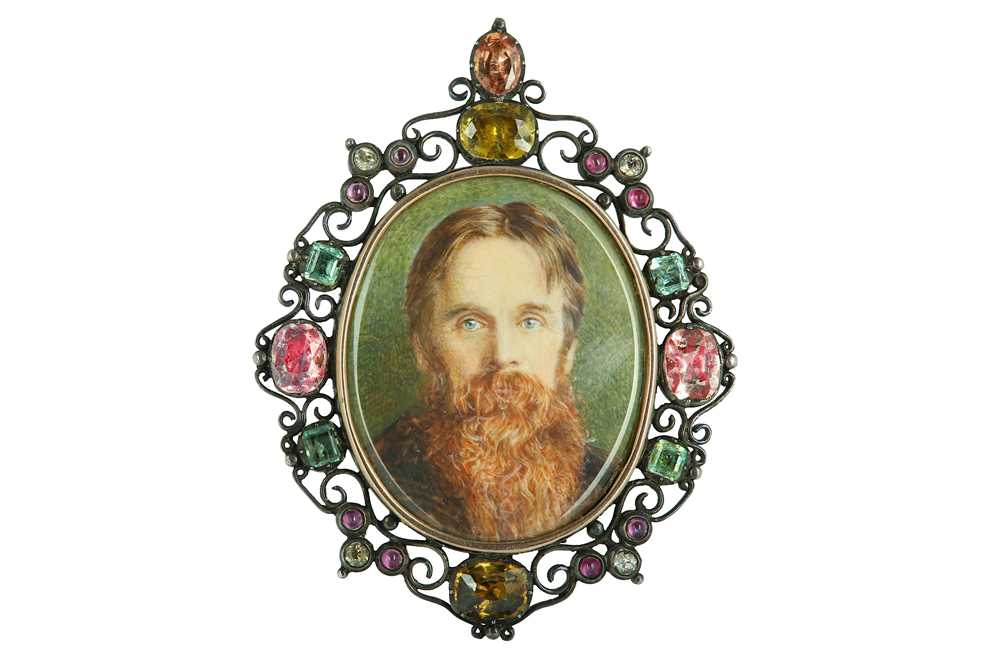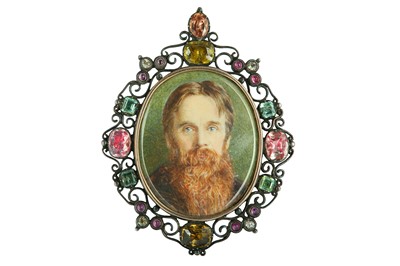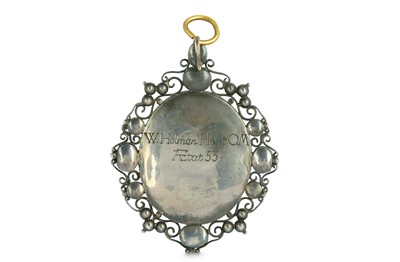25th Mar, 2020 12:00
Fine Portrait Miniatures including The Comerford Collection
EDWARD ROBERT HUGHES (BRITISH 1851-1914) Portrait miniature of William Holman Hunt O.M. (1827-1910), full-face, bearded and with piercing blue eyes Watercolour on ivory Silver frame with pierced scrollwork, set with zircon, rubies, diamonds, foiled green beryl and foiled topaz, engraved on reverse W. Holman Hunt O.M/ Ætat 53 Oval, 42mm (1 ⅝ in) high Provenance: Mrs Emmie Stone; Bonhams, The Albion Collection, 22 April 2004, Lot 164; Private collection Exhibited: H.M., 1999; P.A., 1999; S.N.P.G., 2000-2003; Enchanted Dreams: The Pre-Raphaelite Art of Edward Robert Hughes, October 2015- February 2016, Birmingham Museum and Art Gallery Literature: S.P.N.F., No.103 The inscription on the reverse of the present lot giving the initials O.M. after Hunt's hame and age of 53 is somewhat contrary. Hunt did not receive the Order of Merit until 1905 when he was 78. However, the present lot is based on an earlier photograph of Hunt wearing a striped abà (Eastern robe) (cf. W. Holman-Hunt, O.M., D.C.L., Pre-Raphaelitism and the Pre-Raphaelite Brotherhood, second edition, 1913, II, chap. XII, p.279). This photograph is very similar to one dated August 1891 by Walery, giving us Hunt's age as 53 in the prototype, hence the age that appears on the reverse of the frame. It is probable that the miniature was commissioned by Edith Holman Hunt after her husband's death in September 1910 and before 1914 when Hughes died. Another version of the present lot, also by Hughes is in a private collection of family descent. It has no been possible to confirm whether the present lot is signed on the reverse. Neither portrait miniature is mentioned in the Wills of Holman Hunt, his wife or their son Hilary Lushington Holman Hunt. However, when the latter died, his Will allowed his executors and trustees Emmie Stone and Hannah Meyer (both whom had been nurses to his father) to select such articles of jewellery 'as they may choose to keep'. It would appear that Mrs Stone chose the present lot, which she later gave to a friend. It was then passed to this Gentleman's son, prior to entering the Albion Collection where it was purchased by the present owner in 2005. It has been suggested that the frame is the work of the Arts and Crafts jewellers Arthur and Georgie Gaskin and probably the design of the latter. The open scrollwork, barely three-dimensional and certainly unpretentious, is typical of her work. As in the present lot, she favoured the use of the wirework frame purely as a skeleton to hold a variety of stones providing colour and translucency to a piece. Like many Arts and Crafts jewellers, she chose stones for their interest and beauty rather than rarity or perfection. The present frame is unusual in that it includes a number of diamonds, rarely used by these craftsmen. For a similar pendant by the Gaskins, cf. Charlotte Gere & Geoffrey C. Munn, Artist's Jewellery/ Pre-Raphaelite to Arts and Crafts, 1989, p.145, pl.70. For other examples of her work cf. Exhibition Catalogue Arthur & Georgie Gaskin, City Museum and Art Gallery, Birmingham and The Fine Art Society, London, 1982, section G. William Holman Hunt was born in London on 2 April 1827. A clerk for several years, he left the world of trade to study at the British Museum and the National Gallery. In 1844 he entered the Royal Academy, London. Here he joined with Millais and Rossetti to develop the Pre-Raphaelite theories of art and, in 1848, to found the Pre-Raphaelite Brotherhood. His first canvas to interpret these themes was 'Rienzi', exhibited at the Royal Academy in 1849. In 1854 Hunt went to the Holy Land to portray scenes from the life of Christ, aiming to achieve total historical and archaeological truth. He returned to Palestine in 1869 and again in 1873. Throughout his life Hunt remained dedicated to Pre-Raphaelite concepts, as exemplified in such works as 'The Light of the World', 'The Scapegoat' and 'The Shadow of Death'. Hunt died in Kensington, London on 7 September 1910. Edward Robert Hughes was a nephew of the Pre-Raphaelite Arthur Hughes and a studio assistant to William Holman Hunt. He helped Hunt with some of his later work, including the St Paul's version of 'The Light of the World'. Hughes began his career among the Pre-Raphaelites, and like Edward Burne-Jones with whom he was acquainted, he inclined towards Symbolism. However, the majority of Hughes' work, carried out mainly in watercolour and gouache, display the meticulous observation of nature and minute technique associated with the Pre-Raphaelite movement. The present lot shows how this way of painting enabled him to master the skill of miniature painting, rarely grasped by painters used to working on a large scale. We are grateful to Dr. Judith Bronkhurst for allowing us to reference her research into the attribution and provenance of the present lot.
Sold for £9,375
Includes Buyer's Premium
Do you have an item similar to the item above? If so please click the link below to request a free online valuation through our website.


